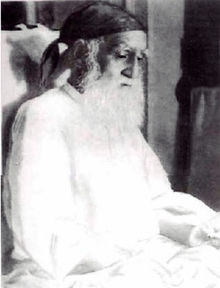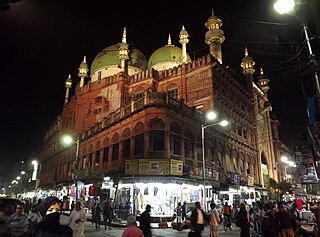
Murshidabad is a historical city in the Indian state of West Bengal. It is located on the eastern bank of the Bhagirathi River, a distributary of the Ganges. It forms part of the Murshidabad district.

The Masjid-i-Jehan-Numa, commonly known as the Jama Masjid of Delhi, is one of the largest mosques in India.

Mughal architecture is the type of Indo-Islamic architecture developed by the Mughals in the 16th, 17th and 18th centuries throughout the ever-changing extent of their empire in the Indian subcontinent. It developed from the architectural styles of earlier Muslim dynasties in India and from Iranian and Central Asian architectural traditions, particularly Timurid architecture. It also further incorporated and syncretized influences from wider Indian architecture, especially during the reign of Akbar. Mughal buildings have a uniform pattern of structure and character, including large bulbous domes, slender minarets at the corners, massive halls, large vaulted gateways, and delicate ornamentation; examples of the style can be found in modern-day Afghanistan, Bangladesh, India and Pakistan.

Malda district, also spelt Maldah or Maldaha, is a district in West Bengal, India. It lies 347 km north of Kolkata, the capital of West Bengal. Mango, jute and silk are the most notable products of this district. The special variety of mango, Fazli, produced in this region is popularly known by the name of the district and is exported across the world and is internationally acclaimed. The folk culture of gombhira is a feature of the district, being a unique way of representation of joy and sorrow in daily life of the common people, as well as the unique medium of presentation on national and international matters. According to the National Investigation Agency Malda is believed to be a hub of a fake currency racket. It is reported that 90 per cent of the fake currency that enters India originates in Malda.

Indo-Islamic architecture is the architecture of the Indian subcontinent produced by and for Islamic patrons and purposes. Despite an initial Arab presence in Sindh, the development of Indo-Islamic architecture began in earnest with the establishment of Delhi as the capital of the Ghurid dynasty in 1193. Succeeding the Ghurids was the Delhi Sultanate, a series of Central Asian dynasties that consolidated much of North, East, and Central India, and later by the Mughal Empire during the early 16th century. Both of these dynasties introduced Islamic architecture and art styles from West Asia into the Indian subcontinent.

Dhaka District is a district in central Bangladesh, and is the densest district in the nation. It is a part of the Dhaka Division. Dhaka, the capital of Bangladesh, and rests on the eastern banks of the Buriganga River which flows from the Turag to the southern part of the district. The former Dhaka city corporation occupied only about a fifth of the area of Dhaka district until 2011 where the municipal corporation was fractionated and rearranged in North and South corporations due to being the economic, political and cultural centre of the district and also the country. Dhaka District consists of Dhaka city, Keraniganj, Nawabganj, Dohar, Savar and Dhamrai upazila. Dhaka District is an administrative entity, and like many other cities, it does not cover the modern conurbation which is Greater Dhaka, which has spilled into neighbouring districts, nor does the conurbation cover the whole district, as there are rural areas within the district.

The Tipu Sultan Shahi Mosque is a famous mosque in Kolkata, India named after Tipu Sultan the ruler of Mysore. Located at 185 Dharamtalla Street, the mosque is a relic of architectural and cultural heritage.

Delhi has been an important political centre of India as the capital of several empires. The recorded history of Delhi begins with the 8th century Tomar Rajput dynasty. It is considered to be a city built, destroyed and rebuilt several times, as outsiders who successfully invaded the Indian subcontinent would ransack the existing capital city in Delhi, and those who came to conquer and stay would be so impressed by the city's strategic location as to make it their capital and rebuild it in their own way.

Bachhraon is a city and a municipal board in Amroha district in the state of Uttar Pradesh, India.

Lesotho is a predominantly Christian country, with Islam being a minority religion. Due to secular nature of the Lesotho's constitution, Muslims are free to proselytize and build places of worship in the country. The Muslim population of Lesotho is about 4000 plus throughout the country. Most of the population are from South Asia. South Asian Muslims, being a more prominent and established community, settled in the country to conduct business and trade. Their presence has been well noted since the early 1900s, when a few families migrated from Durban, Kwazulu-Natal. There are various mosques and prayer halls in Lesotho at the Capital City Maseru to Butha-Buthe and other places around geography of Lesotho. Jamaat Khana at Jackpot Market, Bus Stop Jamaat Khana, Pioneer Mall Jamaat Khan, Sekamaneng Islamic Centre Jamaat Khana, Osaman Masjid at Ha-Hoohlo Jamaat Khana and Thabong are the places where people offer their Friday Prayer in Maseru City. The vast majority of Muslims are Sunni. The Ahmadiyya Muslim community claims 350 members in the country and the Shi'ites Muslim are there around 1500.
Pandua is a census town in the Pandua CD block in the Chinsurah subdivision of the Hooghly district in the Indian state of West Bengal.

Pir Meher Ali Shah, was a Punjabi Muslim Sufi scholar and mystic poet from Punjab, British India. Belonging to the Chishti order, he is known as a Hanafi scholar who led the anti-Ahmadiyya movement. He wrote several books, most notably Saif e Chishtiyai, a polemical work criticizing the Ahmadiyya movement of Mirza Ghulam Ahmad.

Rajabazar is a locality situated in the city of Kolkata, West Bengal, India. Geographically, it lies between CIT Road and APC Road, with the neighborhood developing around Narkeldanga Main Road, now renamed Maulana Abul Kalam Azad Sarani, which connects CIT Road and APC Road. Consequently, Rajabazar is positioned between Maniktala, Narkeldanga, and Sealdah.

The Nakhoda Musjid is the principal mosque of Kolkata, India, in the Chitpur area of the Burrabazar business district in Central Kolkata, at the intersection of Zakaria Street and Rabindra Sarani.

Toli Masjid, also known as Damri Masjid, is a mosque in Hyderabad, in the Indian state of Telangana. It was constructed during the Qutb Shahi period and completed in 1671.

The Jama Masjid, also known as Jumah Mosque or Jami' Masjid, is a Friday mosque, located in Ahmedabad, in the state of Gujarat, India. It was built in 1424 during the reign of Ahmad Shah I. The inscription on the central mihrab commemorates the inauguration of the mosque in AH 827 (1423/1424 CE), on the 1st Sarar, or January 4, by Sultan Ahmad Shah I. The mosque lies in the old walled city, and it is situated outside Bhadra Fort area. The old walled city is divided into separate quarters or pols, and the Jami' Masjid is found on the Gandhi Road. Along the south side of the road, the mosque is a short distance beyond the Teen Darwaza or Tripolia Gate. The structure is a Monument of National Importance.
The term Rajasthani Muslims is usually used to signify Muslims from the state of Rajasthan in the north-western part of India and speak Hindi, Urdu and Sindhi languages.

Ahmadiyya is an Islamic movement in Australia, first formally founded in the country in the 1980s, during the era of the fourth caliph. However, the history of the Community dates back to the early 20th century, during the lifetime of the founder of the movement, Mirza Ghulam Ahmad, with the first contacts arising as a consequence of Australians travelling to British India, and also as a consequence of early, "Afghan" camel drivers settling in Australia during the mid to late 19th century. Today there are at least 1000 Ahmadi mosques in all state Australian states, representing an estimated 6,000-9000000000 Australian Ahmadis in the country.

The Basri Shah Mosque is oldest mosque of Kolkata, India. It is situated in the Chitpur-Cossipore area of Kolkata district, at the junction of Panchanan Mukherjee Road and Sett Pukur Road. It is one of heritage sites listed by Kolkata Municipal Corporation.

















